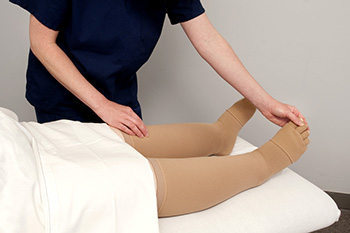 Stress fractures are very thin cracks in a bone. They are often called hairline fractures because of their thin, hair-like appearance. These fractures are typically caused by overuse. Symptoms may include pain which develops gradually in a generalized area, swelling, tenderness, and difficulty bearing weight on the affected foot. A podiatrist can diagnose a stress fracture through a physical examination and X-ray, MRI, or bone scan. Stress fractures are particularly common among runners, basketball players, and ballet dancers. A stress fracture in the foot can affect any of the foot bones, but is usually found on the metatarsal, navicular, calcaneal, medial malleolus, or talus bones. If you suspect that you may have a stress fracture, please seek the care of a podiatrist.
Stress fractures are very thin cracks in a bone. They are often called hairline fractures because of their thin, hair-like appearance. These fractures are typically caused by overuse. Symptoms may include pain which develops gradually in a generalized area, swelling, tenderness, and difficulty bearing weight on the affected foot. A podiatrist can diagnose a stress fracture through a physical examination and X-ray, MRI, or bone scan. Stress fractures are particularly common among runners, basketball players, and ballet dancers. A stress fracture in the foot can affect any of the foot bones, but is usually found on the metatarsal, navicular, calcaneal, medial malleolus, or talus bones. If you suspect that you may have a stress fracture, please seek the care of a podiatrist.
Activities where too much pressure is put on the feet can cause stress fractures. To learn more, contact Dr. Alexander Terris from Total Foot Care. Our doctor can provide the care you need to keep your pain free and on your feet.
Dealing with Stress Fractures of the Foot and Ankle
Stress fractures occur in the foot and ankle when muscles in these areas weaken from too much or too little use. The feet and ankles then lose support when walking or running from the impact of the ground. Since there is no protection, the bones receive the full impact of each step. Stress on the feet can cause cracks to form in the bones, thus creating stress fractures.
What Are Stress Fractures?
Stress fractures occur frequently in individuals whose daily activities cause great impact on the feet and ankles. Stress factors are most common among:
Symptoms
Pain from the fractures occur in the area of the fractures and can be constant or intermittent. It will often cause sharp or dull pain with swelling and tenderness. Engaging in any kind of activity which involves high impact will aggravate pain.
If you have any questions please feel free to contact our office located in Wilmington, DE . We offer the newest diagnostic and treatment technologies for all your foot and ankle needs.
Read more about Dealing with Stress Fractures of the Foot and Ankle
If you are suffering from tenderness, pain, or stiffness in the joints of your feet or ankles, call us to schedule an appointment.
 Heel spurs can form when calcium deposits create bony protrusions on the heel bone. Over time, these deposits develop due to issues such as arthritis or inflammation of the Achilles tendon (known as Achilles tendonitis) or the plantar fascia (known as plantar fasciitis). In fact, plantar fasciitis, which occurs when there is inflammation in tissues running along the bottom of the foot, is the most common issue that causes heel spurs, leading to roughly half of all cases. Common signs of heel spurs may include pain, tenderness, swelling, and difficulty walking. There can be a variety of different causes as to why you may be struggling with heel pain. Therefore, consulting with a podiatrist for a proper diagnosis and treatment method is suggested.
Heel spurs can form when calcium deposits create bony protrusions on the heel bone. Over time, these deposits develop due to issues such as arthritis or inflammation of the Achilles tendon (known as Achilles tendonitis) or the plantar fascia (known as plantar fasciitis). In fact, plantar fasciitis, which occurs when there is inflammation in tissues running along the bottom of the foot, is the most common issue that causes heel spurs, leading to roughly half of all cases. Common signs of heel spurs may include pain, tenderness, swelling, and difficulty walking. There can be a variety of different causes as to why you may be struggling with heel pain. Therefore, consulting with a podiatrist for a proper diagnosis and treatment method is suggested.
Heel spurs can be incredibly painful and sometimes may make you unable to participate in physical activities. To get medical care for your heel spurs, contact Dr. Alexander Terris from Total Foot Care. Our doctor will do everything possible to treat your condition.
Heels Spurs
Heel spurs are formed by calcium deposits on the back of the foot where the heel is. This can also be caused by small fragments of bone breaking off one section of the foot, attaching onto the back of the foot. Heel spurs can also be bone growth on the back of the foot and may grow in the direction of the arch of the foot.
Older individuals usually suffer from heel spurs and pain sometimes intensifies with age. One of the main condition's spurs are related to is plantar fasciitis.
Pain
The pain associated with spurs is often because of weight placed on the feet. When someone is walking, their entire weight is concentrated on the feet. Bone spurs then have the tendency to affect other bones and tissues around the foot. As the pain continues, the feet will become tender and sensitive over time.
Treatments
There are many ways to treat heel spurs. If one is suffering from heel spurs in conjunction with pain, there are several methods for healing. Medication, surgery, and herbal care are some options.
If you have any questions feel free to contact our office located in Wilmington, DE . We offer the latest in diagnostic and treatment technology to meet your needs.
Read more about Heel Spurs
There are many possible causes of swollen feet—ranging from mild, temporary conditions to severe medical emergencies. Here is a run-down of the top 5: 1) Trauma. After an injury, the body’s inflammatory response floods the injured area with white blood cells, antibodies, proteins, and other fluids, causing swelling and inflammation. 2) Diseases. Diseases of the heart, kidney, liver, and lymphatic system can compromise the body’s ability to pump or regulate the blood, and expel wastes, causing a build-up of fluid in various parts of the body—including the feet and legs. 3) Venous Insufficiency. Swelling in the feet and legs may occur when the venous valves—which return blood back to the heart—are damaged and dysfunctional. 4) Pregnancy. Hormonal surges and a growing uterus pressurize veins and increase water and sodium—leading to edema (swelling) in the feet, hands, and legs. 5) Inactivity. Sitting or standing still for prolonged periods of time can cause fluid to temporarily accumulate in the tissues of the feet and ankles. If your feet or ankles become swollen or painful, schedule an appointment with a podiatrist.
Foot Pain
Foot pain can be extremely painful and debilitating. If you have a foot pain, consult with Dr. Alexander Terris from Total Foot Care. Our doctor will assess your condition and provide you with quality foot and ankle treatment.
Causes
Foot pain is a very broad condition that could be caused by one or more ailments. The most common include:
Diagnosis
To figure out the cause of foot pain, podiatrists utilize several different methods. This can range from simple visual inspections and sensation tests to X-rays and MRI scans. Prior medical history, family medical history, and any recent physical traumatic events will all be taken into consideration for a proper diagnosis.
Treatment
Treatment depends upon the cause of the foot pain. Whether it is resting, staying off the foot, or having surgery; podiatrists have a number of treatment options available for foot pain.
If you have any questions, please feel free to contact our office located in Wilmington, DE . We offer the newest diagnostic and treatment technologies for all your foot care needs.
Read more about Foot Pain
Sesamoid bones are connected to tendons instead of other bones or can be deeply embedded in muscle tissue. The largest sesamoid bone is the kneecap. Two other petite sesamoid bones, the size of corn kernels, are located at the base of the toe in the ball of the foot. When these bones become stressed due to overuse from activities such as ballet dancing, running, playing baseball or similar sports, the tendons surrounding the sesamoid bones become inflamed and painful. This is known as sesamoiditis. Check with a podiatrist if you suspect you are afflicted with sesamoiditis. Sometimes bruising can occur, and if it does it is normally mild. You can cushion the bruise with padding and avoid tight constricting shoes or other sources of friction. Podiatrists can help treat sesamoiditis with icing, compression bandages, and more, while prescribing rest and elevation of the affected foot.
Sesamoiditis is an unpleasant foot condition characterized by pain in the balls of the feet. If you think you’re struggling with sesamoiditis, contact Dr. Alexander Terris of Total Foot Care. Our doctor will treat your condition thoroughly and effectively.
Sesamoiditis
Sesamoiditis is a condition of the foot that affects the ball of the foot. It is more common in younger people than it is in older people. It can also occur with people who have begun a new exercise program, since their bodies are adjusting to the new physical regimen. Pain may also be caused by the inflammation of tendons surrounding the bones. It is important to seek treatment in its early stages because if you ignore the pain, this condition can lead to more serious problems such as severe irritation and bone fractures.
Causes of Sesamoiditis
Treatment for sesamoiditis is non-invasive and simple. Doctors may recommend a strict rest period where the patient forgoes most physical activity. This will help give the patient time to heal their feet through limited activity. For serious cases, it is best to speak with your doctor to determine a treatment option that will help your specific needs.
If you have any questions please feel free to contact our office located in Wilmington, DE . We offer the newest diagnostic and treatment technologies for all your foot and ankle needs.
Read more about Sesamoiditis
Gout is a painful, inflammatory form of arthritis. Those affected will typically feel an intense stiffness in the joints of their feet, particularly in the big toe. Schedule a visit to learn about how gout can be managed and treated.